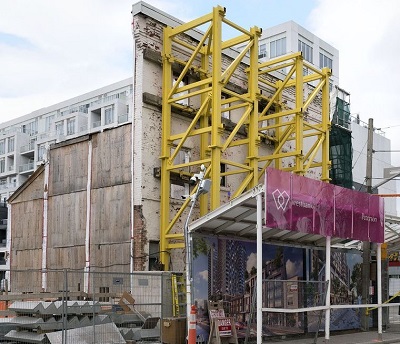 Saturday, September 28, 2024
Saturday, September 28, 2024  Saturday, September 28, 2024
Saturday, September 28, 2024 
There isn’t much left of the former Ka Chi Korean Restaurant near the intersection of Bloor Street West and Bathurst Street in downtown Toronto. The roof of the building, once part of a streetscape, has been removed. Two walls have been torn down and the interior has been completely gutted.
The remaining two walls wouldn’t be standing either if they weren’t propped up and held in place by gigantic steel beams.
The three-storey building, which has housed other restaurants and shops over the decades, is considered of historic value. It couldn’t be completely torn down when the surrounding 4.5 acres of land were razed to make way for one of Toronto’s biggest commercial and residential developments, Mirvish Village.
More than 20 other heritage buildings on the site have also been saved and they’ll be incorporated into Westbank Corp.’s sprawling development that is expected to wrap by 2022. With most of the construction work so far happening at ground level or below, the two red-brick restaurant walls and their towering yellow exoskeleton stand out all the more.
It’s a sight that is becoming increasingly common across development-crazy Toronto. Heritage buildings, or at least their facades, are being saved under local preservation laws and grafted on to modern towers that are shooting up into the city’s skyline.
Combining the two is a complicated feat of engineering and construction. But it wouldn’t be possible, to begin with, without the humble contribution of the multitonne steel frames and superstructures that temporarily support the old while the new is created.
In Toronto, especially, but also somewhat in Vancouver, developers are running out of parking lots and other vacant land to build on in the core, so they’re turning to sites with existing buildings, some of which must be preserved and worked around.
Among the first steps is enveloping the saved buildings or their facades with a sturdy structure so they don’t topple or collapse into the construction pit.
Keep reading in The Globe and Mail
Check out the video gallery here